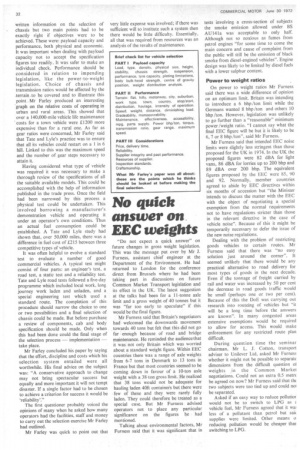No quick answer on EEC weights
Page 34

If you've noticed an error in this article please click here to report it so we can fix it.
"Do not expect a quick answer" on future changes in gross weight legislation. This was the message put over by Mr J. Furness, assistant chief engineer at the Department of the Environment. He had returned to London for the conference direct from Brussels where he had been taking part in discussions on future Common Market Transport legislation and its effect in the UK. The latest suggestion at the talks had been for a 11-tonne axle limit and a gross weight of 40 tonnes but it was "far too early to speculate" if this would be the final figure.
Mr Furness said that Britain's negotiators had welcomed the downwards movement towards 40 tons but felt that this did not go far enough because of road and bridge maintenance. He reminded the audience that it was. not only Britain which was worried about a standard weight figure. Within EEC countries there was a range of axle weights from 6-7 tons in Denmark to 13 tons in France but that most countries seemed to be coming down in favour of a 10-ton axle weight with a 38-ton gross limit. He realized that 38 tons would not be adequate for hauling laden 40ft containers but there were few of these and they were rarely fully laden. They could therefore be treated as a special case. But Mr Furness advised operators not to place any particular significance on the figures he had mentioned.
Talking about environmental factors, Mr Furness said that it was significant• that in tests involving a cross-section of subjects the smoke emission allowed under BS AU141a was acceptable to only half. Although not so noxious as fumes from petrol engines "for some time to come the main concern and cause of complaint from the public will Still be the emission of black smoke from diesel-engined vehicles". Engine design was likely to be limited by diesel fuels with a lower sulphur content.
Power to weight ratios On power to weight ratios Mr Furness said there was a wide difference of opinion on an optimum limit. Britain was intending to introduce a 6 bhp/ton limit while the Germans wanted 8 bhp/ton and others 10 bhp /ton. However, legislation was unlikely to go further than a "reasonable" minimum power /weight ratio. "I cannot say what the final EEC figure will be but it is likely to be 6, 7 or 8 bhp/ton", said Mr Furness.
Mr Furness said that intended EEC noise limits were slightly less stringent than those proposed for the UK in 1974. In the UK the proposed figures were 82 dBA for light vans, 86 dBA for lorries up to 200 bhp and 89 dBA over 200 bhp. The equivalent figures proposed by the EEC were 85, 90 and 92. Normally, member countries agreed to abide by EEC directives within six months of accession but "the Minister intends to discuss the matter with the EEC with the object of negotiating a special exemption from the normal requirements not to have regulations stricter than those in the relevant directive in the case of vehicle noise". Because of this it might be temporarily necessary to defer the issue of the new noise regulations.
Dealing with the problem of restricting goods vehicles to certain routes, Mr Furness said that there was "no easy solution just around the corner". It seemed unlikely that there would be any practical alternative to road delivery for most types of goods in the next decade. Even if the tonnage of freight carried by rail and water was increased by 50 per cent the decrease in road goods traffic would be small (perhaps one or two per cent). Because of this the DoE was carrying out research into routeing of vehicles but "it will be a long time before the answers are known". In many congested areas extensive exemptions would be required to allow for access. This would make enforcement for any restricted route plan difficult.
During question time the seminar chairman, Mr L. J. Cotton, transport adviser to Unilever Ltd, asked Mr Furness whether it might not be possible to separate dimensions from the difficult question ol weights .in the Common Markel negotiations. Could not an extra 0.5 metre be agreed on now? Mr Furness said that the two subjects were too tied up and could nu be separated.
Asked if an easy way to reduce pollutior would not he to switch to LPG as vehicle fuel, Mr Furness agreed that it wal less of a pollutant than petrol but sale supplies were limited. Other means a reducing pollution would be cheaper that switching to LPG.




























































































